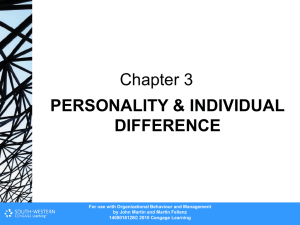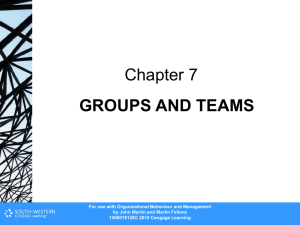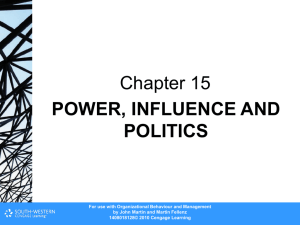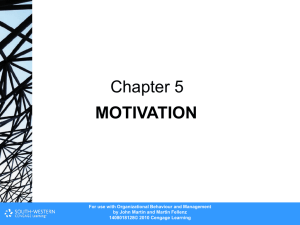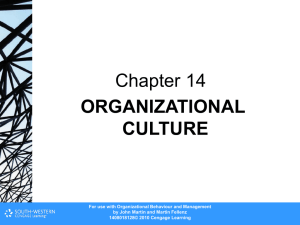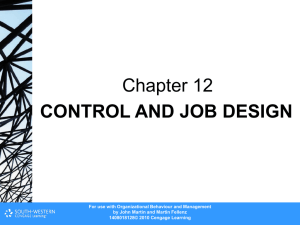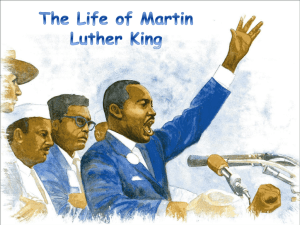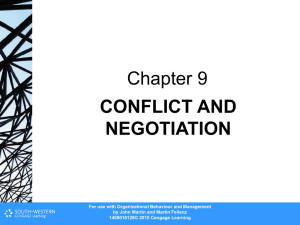Chapter 1 - Cengage Learning
advertisement
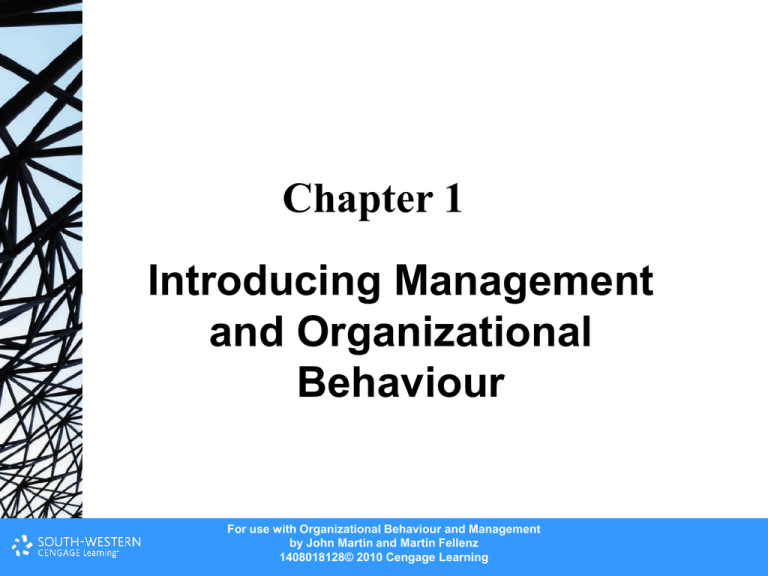
Chapter 1 Introducing Management and Organizational Behaviour For use with Organizational Behaviour and Management by John Martin and Martin Fellenz 1408018128© 2010 Cengage Learning WHAT ARE ORGANIZATIONS? Organizations are: social entities that are goal-directed, that are inextricably linked to their environment yet have nominal boundaries, and that employ deliberately designed and coordinated activities and approaches to achieving their objectives. For use with Organizational Behaviour and Management by John Martin and Martin Fellenz 1408018128© 2010 Cengage Learning WHY DO ORGANIZATIONS EXIST? • They are more effective than the alternatives - they offer the opportunity to achieve objectives unachievable without them; and • They offer efficiencies compared to their alternatives - they help achieve these objectives faster or with less economic, cultural, social, political, or moral costs. For use with Organizational Behaviour and Management by John Martin and Martin Fellenz 1408018128© 2010 Cengage Learning WHAT IS MANAGEMENT? • Management – a process that involves planning, organizing, leading (or deploying), and controlling resources in order to achieve goals • People management - the process of trying to achieve goals in organizations with and through people. For use with Organizational Behaviour and Management by John Martin and Martin Fellenz 1408018128© 2010 Cengage Learning The process of management • Figure 1.1 For use with Organizational Behaviour and Management by John Martin and Martin Fellenz 1408018128© 2010 Cengage Learning WHAT IS MANAGEMENT? • Involves: – complexity - a large number of potentially relevant factors that may have a bearing on the intended outcome, and – uncertainty - the absence of sufficient information about the nature and likelihood of certain events that may have a bearing on the intended outcome For use with Organizational Behaviour and Management by John Martin and Martin Fellenz 1408018128© 2010 Cengage Learning WHAT IS ORGANIZATIONAL BEHAVIOUR? • OB is concerned with the behaviour of individuals and groups in an organizational context • Its main sphere of interest includes anything relevant to the design, management and effectiveness of an organization, together with the dynamic and interactive relationships that exist within them For use with Organizational Behaviour and Management by John Martin and Martin Fellenz 1408018128© 2010 Cengage Learning WHAT IS ORGANIZATIONAL BEHAVIOUR? • The study of OB involves two distinct features: – Interdisciplinary - draws from research in psychology, sociology, political science, economics, anthropology, philosophy, ergonomics, other social sciences disciplines – Explanatory - sets out to explain the behaviour of individuals and groups in organizations. in the form of theories and models that describe the relationships between variables For use with Organizational Behaviour and Management by John Martin and Martin Fellenz 1408018128© 2010 Cengage Learning WHY STUDY ORGANIZATIONAL BEAHVIOUR? • Most jobs contain a technical and people oriented dimension • Organizations are complex, dynamic places • Helps to understand ambiguity in the social world and to be more able to work with and around those uncertainties • Creates self-awareness that will help understand how you and others interface with organizations, and so equip you to better survive the experience of doing so! For use with Organizational Behaviour and Management by John Martin and Martin Fellenz 1408018128© 2010 Cengage Learning HOW TO STUDY ORGANIZATIONAL BEHAVIOUR • Get involved • Consider all the organizations that you have been involved with • Think about all of the jobs that you have done • Think about the movies , books and games that involve jobs • Integrate all your experience and reading about organizations For use with Organizational Behaviour and Management by John Martin and Martin Fellenz 1408018128© 2010 Cengage Learning The Impact of People and Organizations on Management • Figure 1.2 For use with Organizational Behaviour and Management by John Martin and Martin Fellenz 1408018128© 2010 Cengage Learning Reciprocal impact between management and aspects related to people and organizational context • Figure 1.3 For use with Organizational Behaviour and Management by John Martin and Martin Fellenz 1408018128© 2010 Cengage Learning Comprehensive Framework for Organizational Behaviour and Management in Organizations •Figure 1.4 For use with Organizational Behaviour and Management by John Martin and Martin Fellenz 1408018128© 2010 Cengage Learning RESEARCH AND ORGANIZATIONAL BEHAVIOUR • Figure 1.5 For use with Organizational Behaviour and Management by John Martin and Martin Fellenz 1408018128© 2010 Cengage Learning Critical studies Reed (1989) identifies three important sociological perspectives on management: • Technical perspective. • Political perspective. • Critical perspective. For use with Organizational Behaviour and Management by John Martin and Martin Fellenz 1408018128© 2010 Cengage Learning Critical studies • Requires approaches to the study of organizations to be: – Reflexive – Embedded – Multi-dimensional – Dialectical and contradictory – Socially transforming For use with Organizational Behaviour and Management by John Martin and Martin Fellenz 1408018128© 2010 Cengage Learning Critical studies • Alvesson & Willmott (1996) describe the critical perspective as incorporating the following: – Management is a social practice – Tensions exist in management practice – Critical studies are themselves embedded – Critical studies seek to illuminate and transform power relations – Critical theory contains an emancipatory intent – Critical analysis is concerned with the critique of ideology – Critical theory implies more than a reconstruction of mainstream For use with Organizational Behaviour and Management by John Martin and Martin Fellenz perspectives 1408018128© 2010 Cengage Learning Modernism and postmodernism • Thompson & McHugh (1995) suggest that: – Modernism is the representational aspects of the ‘grand narrative, a coherent story about the development of the social and natural, revealed through the application of reason and science’ – Postmodernists, reject that cohesion, arguing that reality is made up of a differing range of realities and that it is constructed by our ability to express (or formulate) it. It is a view that holds that the ‘truth is a product of language games’ For use with Organizational Behaviour and Management by John Martin and Martin Fellenz 1408018128© 2010 Cengage Learning


